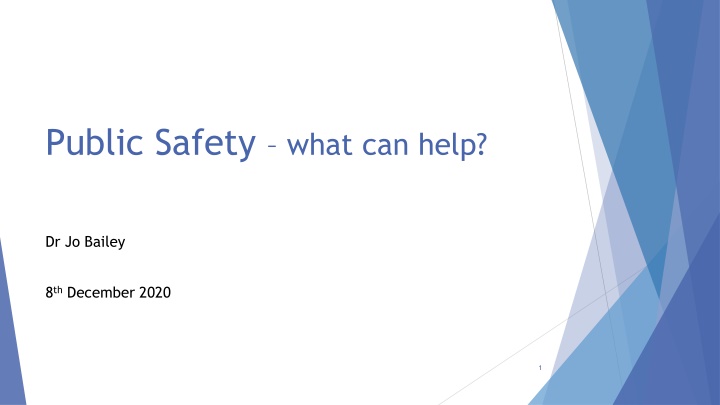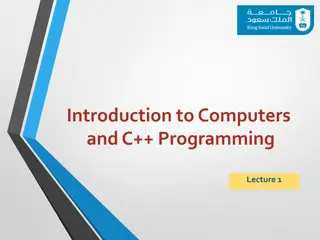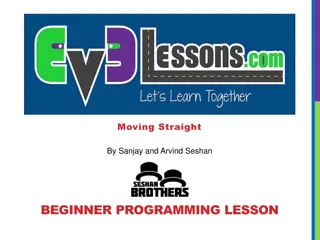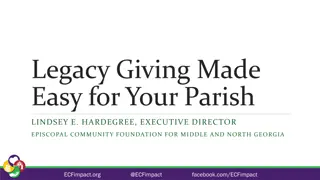Lesson Plan: Giving Specific Instructions in Computer Programming
Students will learn to give and follow precise instructions through a water bottle demonstration activity. They will explore the connection between giving specific instructions in programming and everyday tasks. The lesson encourages creativity and flexibility in expressing emotions and identities through art and design elements. Students will engage in discussions to reflect on their experiences as both programmers and followers of instructions, drawing parallels to computer programming concepts.
Download Presentation

Please find below an Image/Link to download the presentation.
The content on the website is provided AS IS for your information and personal use only. It may not be sold, licensed, or shared on other websites without obtaining consent from the author.If you encounter any issues during the download, it is possible that the publisher has removed the file from their server.
You are allowed to download the files provided on this website for personal or commercial use, subject to the condition that they are used lawfully. All files are the property of their respective owners.
The content on the website is provided AS IS for your information and personal use only. It may not be sold, licensed, or shared on other websites without obtaining consent from the author.
E N D
Presentation Transcript
Public Safety what can help? Dr Jo Bailey 8thDecember 2020 1
Risk Approaches Risk Formulation: integrating and organising separate risk factors into a meaningful framework that explains a person s offending. It provides the information base for risk management. Risk Management: Aims to minimise the likelihood of adverse events, to achieve the best possible outcome, and deliver safe, appropriate, effective care. View risk as an ongoing, changing entity, rather than one in which one-time, yes/no predictions would be appropriate 2
Risk Assessment Static vs Dynamic Static factors generally don t change over time. Development in Approach 1st Generation unstructured clinical judgement 2nd Generation actuarial / static assessments Dynamic variables are amenable to change. 3rd Generation structured professional judgement (SPJ); e.g. SARA, HCR-20V2 The earlier prediction-focused approach was mainly based on research linked to static factors. 4th Generation structured professional judgement with a greater focus on risk management and future planning; e.g. RSVP, HCR-20V3 Dynamic variables are of particular interest when looking at risk reduction. 3 Risk assessment is not infallible
Desistance Risk Need Responsivity (RNR) Different lens for the same issue? Positive Psychology Good Lives Model (GLM)
Some approaches which may be intuitive, but dont seem to work as approaches to reducing reoffending Punishment services or interventions based on punishment, have the notion that people will avoid committing crimes if they understand the negative consequences of offending, or to avoid increasingly onerous punishment have been shown repeatedly to fail to reduce reoffending Simply facilitating access to employment etc without building the skills Deterrence scared straight approaches which aim to deter by showing people what will happen to them don t work and in some cases increase likelihood Discipline teaching discipline through military style bootcamps without other strengths approaches does not work Insight oriented focus on increasing insight/awareness such as victim awareness do not have an impact 5
Why dont they work? Develop only extrinsic motivation Fail to build any skills Reinforce a criminal identity Fail to target factors associated with reoffending Poor implementation
7 Pathways: Accommodation Education Training and Employment Health Drugs & Alcohol Finance Children and Families Attitudes Thinking and Behaviour
Limited experience of work Convictions a barrier Employment Moderate evidence; promising approaches include: Increased employability in the form of skills and motivation to work and confidence to relate constructively to others in the work setting. Steady employment particularly if it offers a sense of achievement or satisfaction Unable to find employment, unemployed, poor performance or low satisfaction at work; lack of work related skills, poor attitude to employment, lack of qualifications. Unable to deal with stress and challenges of work Unstable or poor quality work Literacy, numeracy and life skills (where needed) If you have a job on release you are less likely to reoffend (by 5- 9 percentage points) Vocational/education/work training in prison can have a significant impact on reoffending For women, unemployment is one of the areas most predictive of reoffending It matters that employment is appropriate and meaningful and it gives you a sense of achievement Your attitudes toward employment (such as a willingness to take a poorly paid job and use this as a stepping stone) makes a difference Stability of employment is also important Employment-focused programmes that lead to real jobs Gaining work related qualifications, gaining employability skills including problem solving and self-management Work-related mentoring
Accommodation In emergency hostel Squatting Sleeping rough No fixed abode, transient, or returning to a criminogenic neighbourhood In B&B Unsafe Finding and keeping suitable housing Living in intolerable physical conditions Limited evidence but promising approaches may be: You are more likely to be homeless if you are in prison Accommodation problems are worse if you have a drug/alcohol problem And worse if you ve been sentenced before The first 6 months out are particularly important for long term housing Approaches that aim to achieve long term housing solutions, rather than temporary or crisis solutions Services which also address the causes of homelessness such as poor mental health, substance misuse, and lack of employment Reoffending You are more likely to reoffend if homeless before custody And if you need help with accommodation on release Half-way houses may reduce reoffending but not if they reinforce criminal identities Intensive case management help to secure accommodation or linking people to existing housing services
Programmes and interventions that help develop pro-social Attitudes, Thinking, Behaviour and Relationships Clear model of change Programmes and interventions Provide sentencing options in the community and rehabilitative opportunities in prison. Teach multiple skills especially social skills Target medium or high risk offenders Address four of the most predictive criminogenic needs: 1. Impulsivity and low self control 2. Attitudes that support crime 3. Social networks involved in crime 4. Poor family/marital relationships These factors have been found to increase programme effectiveness Motivate, engage and retain participants Focus on factors that predict reoffending Use trained staff and ensure quality of delivery Continuous evaluation to learn and improve 10
We can increase public safety (and reduce reoffending by) enabling people to move from . 11
Building Strengths and Hope Building Strengths and Hope Letting people know you believe in them Encouraging people Managing people s mistakes discreetly Modelling a helpful approach Getting people involved and taking responsibility Helping people develop skills and confidence so they feel empowered Facilitating people in supporting each other and sharing experiences Helping people develop realistic goals























